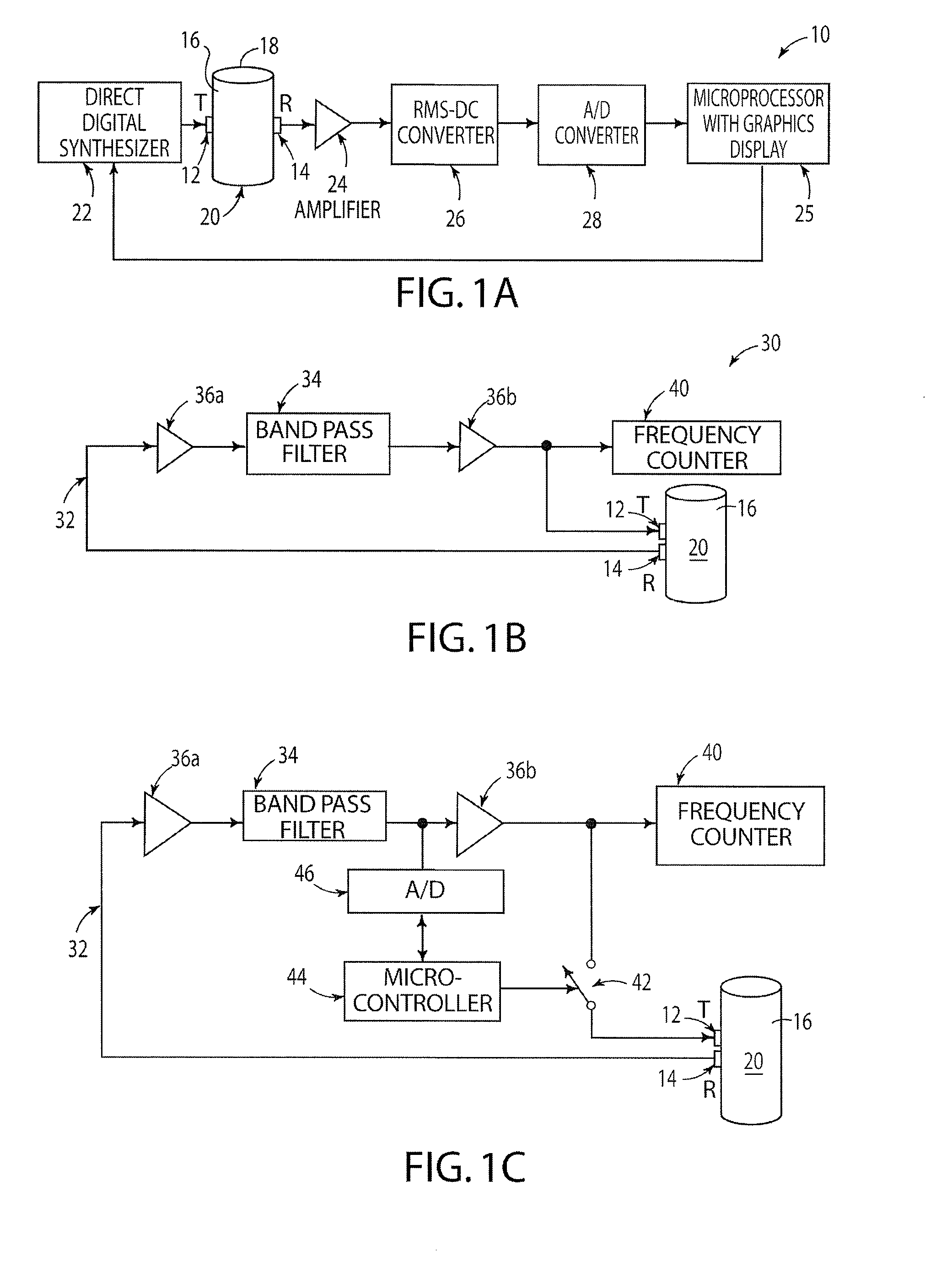Non-invasive fluid density and viscosity measurement
- Summary
- Abstract
- Description
- Claims
- Application Information
AI Technical Summary
Benefits of technology
Problems solved by technology
Method used
Image
Examples
example 1
[0032]FIG. 2 is a graph of amplitude of the received vibration signal as a function of frequency for swept frequency vibration excitation applied to the pipe surface between about 1 kHz and about 1.5 kHz. Measurements were made using a 23 cm long section of a 1.8 mm thick, 7.3 cm diameter copper pipe with three fluids: corn syrup (ρ=1.350 g / cm3), water (ρ=0.998 g / cm3) and cooking oil (corn oil ρ=0.922 g / cm3). The vibration modes show clear separation in resonance frequency, but the lower frequency mode showed greater resolution among the resonances and was used for the density measurement. In fact, higher modes may be used, but with different density resolutions. As stated hereinabove, the full-width-at-half-maximum of the peaks is proportional to the viscosity of the fluids.
example 2
[0033]FIG. 3 is a plot of the resonance vibration frequency as a function of fluid density for four fluids: Motor oil 10-30 (ρ=0.863 g / cm3), water (ρ=0.998 g / cm3), ethylene glycol (anti-freeze, ρ=1.136 g / cm3), and glycerol (ρ=1.350 g / cm3), for a steel pipe that has significantly greater wall thickness and is much larger than the one used in the collection of data for FIG. 2 (a 5-mm thick wall, a diameter of 15 cm, and a length of 60 cm). The measured resonance frequencies of the lowest vibration mode of the pipe are shown as dots, and the curve fit to the data with using theory is shown as the solid line. The theoretical form for the equation is the same as that set forth hereinabove for the vibrating tube densitometer, and illustrates that the behavior of the density measurements in a pipe follows the same form. The measured resonance frequency of the empty pipe is 2.7 kHz which is in good agreement with that derived from the curve fit of the data (2.673 kHz).
example 3
[0034]FIG. 4 is a graph of the fluid viscosity plotted as √{square root over (μρfluid)}, as a function of the widths, Δƒ of the first resonances for the fluids shown in FIG. 2 hereof. The experimental data are shown by the black dots, and a plot the equation:
ρfluidμ=0.15+0.112exp(Δf2.254),
using literature values for √{square root over (μρfluid)} fits the experimental data well. As stated hereinabove, the decay time-constants measured in the experiment and the resonance widths are related and provide the same information, one being in the frequency domain and the other in the time domain. The equation parameters are slightly different for the second set of resonance peaks shown in FIG. 2 hereof because of different sensitivity, but the form is the same.
[0035]Thus, attenuation by a fluid in a pipe clearly damps vibration resonance curves. This effect manifests itself in two different ways: (1) the width of the resonance is broadened as the density of the enclosed fluid increases; and ...
PUM
| Property | Measurement | Unit |
|---|---|---|
| frequency | aaaaa | aaaaa |
| frequency | aaaaa | aaaaa |
| frequency bandwidth | aaaaa | aaaaa |
Abstract
Description
Claims
Application Information
 Login to View More
Login to View More - R&D
- Intellectual Property
- Life Sciences
- Materials
- Tech Scout
- Unparalleled Data Quality
- Higher Quality Content
- 60% Fewer Hallucinations
Browse by: Latest US Patents, China's latest patents, Technical Efficacy Thesaurus, Application Domain, Technology Topic, Popular Technical Reports.
© 2025 PatSnap. All rights reserved.Legal|Privacy policy|Modern Slavery Act Transparency Statement|Sitemap|About US| Contact US: help@patsnap.com



